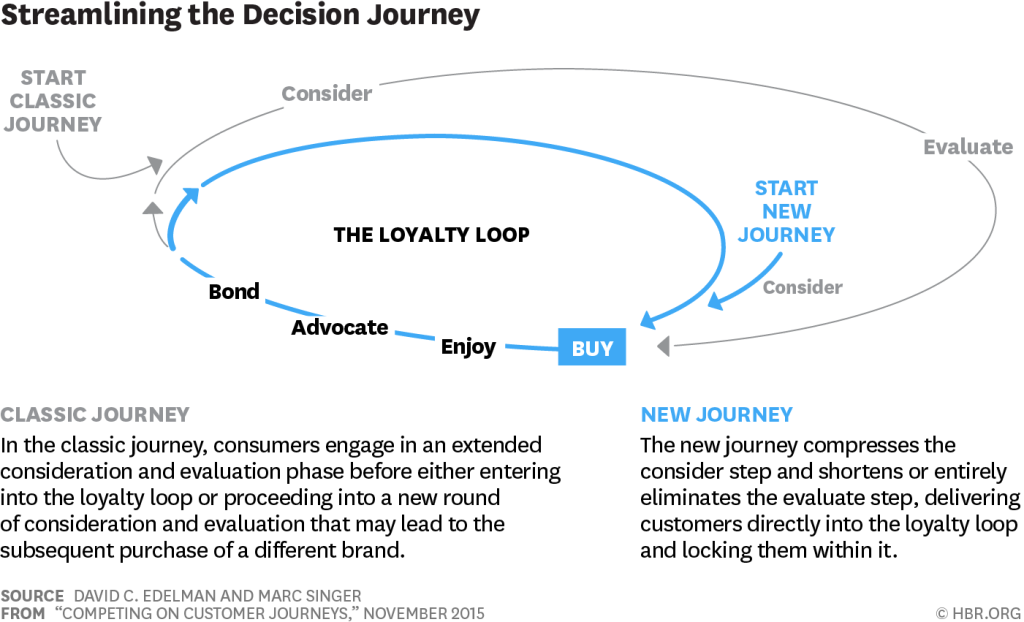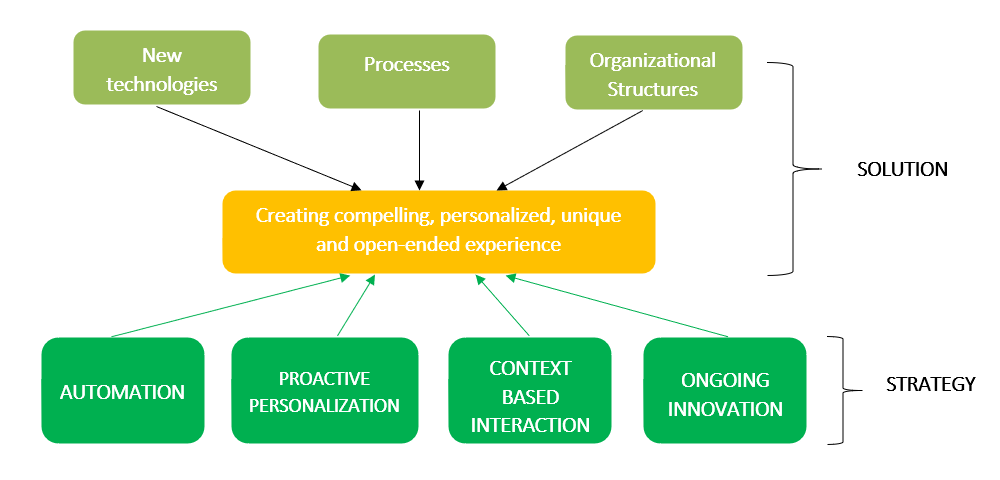Which customer journeys are you orchestrating?
The magic band case study
Welcome Mr. Tanner! Sit anywhere you like! Your food will find you.
“It’s like magic!” a woman says to her family as they sit. “How do they find our table?” The dining hall, inspired by Beauty and the Beast, features Baroque details but feels like a large, orderly cafeteria. Soon, their food arrives exactly as promised, delivered by a smiling young man.

Their MagicBands, tech-studded wristbands available to every visitor to the Magic Kingdom, feature a long-range radio that can transmit more than 40 feet in every direction. The hostess, on her modified iPhone, received a signal when the family was just a few paces away. Tanner family inbound! The kitchen also queued up: Two French onion soups, two roast beef sandwiches! When they sat down, a radio receiver in the table picked up the signals from their MagicBands and triangulated their location using another receiver in the ceiling. The server—as in waitperson, not computer array—knew what they ordered before they even approached the restaurant and knew where they were sitting. And it all worked seamlessly, like magic.”
The magic band can also unlock the door of the customer’s Disney Resort hotel room; be used to enter theme and water parks (with valid admission); check in at FastPass+ entrances; connect Disney PhotoPass images to customer’s account; and charge food and merchandise purchases to customer’s Disney Resort hotel room (only available during the stay).
Disney is one of a few performers who are leading the competition on customer journey.
If a customer is interacting with a company, they expect a seamless, personalized experience.
What’s statistics saying?
According to the studies of Salesforce, 70% of consumers say connected processes – such as seamless handoffs or contextualized engagement based on earlier interactions – are important to winning their business. In fact, 52% of B2C customers say they’d switch brands if they didn’t feel they were getting a personalized experience.
Customers are loyal to experience, not to companies.
The era of digital savvy customers
Companies, therefore, have to be proactive in creating new added values to the customers in the journey, instead of reacting aggressively to the journey consumers devise themselves.
With the explosion of technology, consumers are “empowered” to be the master in their use of tools and information. They can control the whole buying process by seeking for information, comparing prices, online interacting with brands and having the products they want delivered to door. This imposes a dramatic change in consumer decision journey, where the classic decision journey can be obsolete; consumers properly shorten some steps, and develop bonds with brands faster than expected, depending on the values brands can bring to them during the journey.

The challenge for brands is not only to own intelligence about customer demographics, data about past purchase decisions or even what they have browsed at the last visit, but also marketers have to be always ready to deliver tailored and customized experience to customers with the use of customers’ past data, integrate with present contexts and be able to predict future behaviors.
“Because data is live and technology is evolving every single second”
Zarina Lam Stanford is the head of APJ marketing at SAP, in an interview with Campaign Asia, published on issue September 16,2016.
Customer journey vs customer experience
Customer experience is not a new concept, it has been studied since late 20th century. Pine and Gilmore are some of the first authors to address this phenomenon. In their book published in 1998: Welcome to experience economy, or another book the following year: The experience economy – Work is theatre and every business a stage, Pine and Gilmore observed that firms are competing on experience. In the literature regarding to this field, many authors also pointed out the importance of customer experience
The idea is to understand the Customer Experience in order to refine the right Customer Journey.
Customer journey is a set of activities and processes that a customer completes while acquiring a company’s products or services. Customer Experience is the sum of thoughts, feelings, reactions, attitudes, etc, customers have or will have when using the company’s product or service.
Lately, while learning about Salesforce’s product ecosystem and reflecting on the jobs I have been doing as a marketer, I am inspired to write about this topic. Imagine you work as a marketer of a company who is doing business with e-commerce. Think about the journey that a customer is involved when buying your company’s product, from the moment he/she sees the ads on Facebook to a website visit, an add to cart but an abandon after that. As a marketer, you probably ask yourself many questions about the reasons why and how to win them back.
How much do you know about that buyer from the analytics tool? Do you have an automation journey to win back this type of buyer?
There are many more journeys marketers can think of for different types of buyers. But the question is how to do that? What can be the strategy?
One of the articles that I found insightful on customer journey is David Elderman & Marc Singer’s.
Solution and Strategy

The article suggests that to be able to attract customers, earn their loyalty and gain significant competitive advantages in the competition on customer journey, firms should take advantage on the new technologies and develop the internal processes and organizational structures to bring a compelling, personalized and unique experience to customers.
Four key capacities are proposed, which companies should pursue in order to achieve this goal, including: automation, personalization, context-based interaction and ongoing innovation.
A couple of year ago, Big Data was discussed, talked and even embellished as the super powerful tool of marketers. Based on this, automatic personalization targeting is used. For instance, based on the history search, ads related to the past interest will be introduced, and reach the user; or emails marketing are sent with title specifically targets to each user (with their name on it).
Not only in online sphere, in advertising campaign realm, personalization is utilized. Coca Cola with “Share a coke” campaign, brilliantly delivers a very unique customized experience to customers.
In brick and mortal shops, personalization and contextual based interaction are employed to differentiate brands. One time when I was shopping in an outlet of Banana Republic, near the changing rooms, there were several salespersons to support customers when you need. One man asked me my name and started to talk to me by addressing my name. Also, my name was written on the chalkboard on the door. I realized other doors also had the name of each single customer.
However, with this article, the authors define these four key capacities as a holistic strategy that firms should pursue in the long run to build a completely competitive customer journey, with more emphasis on the use of new technologies as a powerful leverage.
Pivotal elements to be successful in this competition
What’s profound and visionary about the suggestions that David and Singer make is the importance of the internal process and organizational structures as the pivotal elements to be successful in this competition. Companies should see journeys as important as the products itself and have strategy to build a supporting cross functional collaboration team to really deliver these values to customers. In another research, Johnston and Kong (2008) also contended that the biggest barrier to change was not the lack of resources but getting the company’s people to see the customer experience from the customer point of view, outside-in.
Because of the significance of customer journey in firms’ business, the article also suggests the role of a chief experience officer with a subordinate position of a journey product manager. It can be noticeable that a technology disruption has changed the customer decision journey, which results in the demand for firms to proactively react, and even new positions appear on the labor market as well.
Where are your company in this fierce competition? How many journeys have you designed for your various segments?
Reference
Case study about the Magical Band of Disney, from the article “Disney’s $1 Billion Bet on a Magical Wristband”, published on WIRED Magazine, issue 3.10.2015
Link to the article: https://www.wired.com/2015/03/disney-magicbaand/
Robert Johnston and Xiangyu Kong. (2011). The customer experience: a road-map for improvement. Managing Service Quality, 5-24
